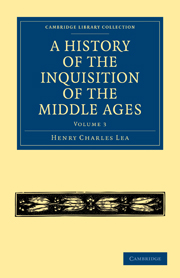Book contents
- Frontmatter
- Contents
- BOOK III SPECIAL FIELDS OF INQUISITORIAL ACTIVITY
- CHAPTER I THE SPIRITUAL FRANCISCANS
- CHAPTER II GUGLIELMA AND DOLCINO
- CHAPTER III THE FRATICELLI
- CHAPTER IV POLITICAL HERESY UTILIZED BY THE CHURCH
- CHAPTER V POLITICAL HERESY UTILIZED BY THE STATE
- CHAPTER VI SORCERY AND OCCULT ARTS
- CHAPTER VII WITCHCRAFT
- CHAPTER VIII INTELLECT AND FAITH
- CHAPTER IX CONCLUSION
- APPENDIX OF DOCUMENTS
- INDEX
CHAPTER V - POLITICAL HERESY UTILIZED BY THE STATE
Published online by Cambridge University Press: 29 August 2010
- Frontmatter
- Contents
- BOOK III SPECIAL FIELDS OF INQUISITORIAL ACTIVITY
- CHAPTER I THE SPIRITUAL FRANCISCANS
- CHAPTER II GUGLIELMA AND DOLCINO
- CHAPTER III THE FRATICELLI
- CHAPTER IV POLITICAL HERESY UTILIZED BY THE CHURCH
- CHAPTER V POLITICAL HERESY UTILIZED BY THE STATE
- CHAPTER VI SORCERY AND OCCULT ARTS
- CHAPTER VII WITCHCRAFT
- CHAPTER VIII INTELLECT AND FAITH
- CHAPTER IX CONCLUSION
- APPENDIX OF DOCUMENTS
- INDEX
Summary
It was inevitable that secular potentates should follow the example of the Church in the employment of a weapon so efficient as the charge of heresy, when they chanced to be in the position of controlling the ecclesiastical organization.
A typical illustration of this is seen when, during the anarchy which prevailed in Rome after the death of Innocent VII. in 1406, Basilio Ordelaffi incurred the enmity of the Colonnas and the Savelli, and they found that the easiest way to deal with him was through the Inquisition. Under their impulsion it seized him and two of his adherents, Matteo and Merenda. Through means procured by his daughter, Ordelafn escaped from prison and was condemned in contumaciam. The others confessed—doubtless under torture—the heresies attributed to them, were handed over to the secular arm, and were duly burned. Their houses were torn down, and on their sites in time were erected two others, one of which afterwards became the dwelling of Michael Angelo and the other of Salvator Rosa.
Secular potentates, however, had not waited till the fifteenth century to appreciate the facilities afforded by heresy and the Inquisition for the accomplishment of their objects. Already a hundred years earlier the methods of the Inquisition had suggested to Philippe le Bel the great crime of the Middle Ages—the destruction of the Order of the Temple.
- Type
- Chapter
- Information
- A History of the Inquisition of the Middle Ages , pp. 238 - 378Publisher: Cambridge University PressPrint publication year: 2010First published in: 1888



